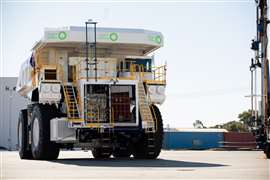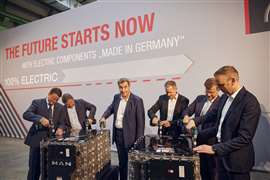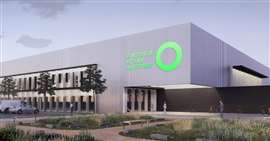Fueling transport’s future hydrogen revolution
31 August 2023
 Hydrogen-powered haul truck operated by Fortescue Energy
Hydrogen-powered haul truck operated by Fortescue Energy
In 2021, Australian mining giant Fortescue Metals Group (FMG) announced it would invest approximately $8.0 billion to develop a green hydrogen production facility located in Argentina. Following analysis of local resources, including the availability of wind energy to support sustainable operations, a $1.2 billion pilot project was set to deliver 35,000 tons of green H2 per year before output was ramped up to about 215,000 tonnes.
The plan was to make the facility in Rio Negro (south-west of Buenos Aires), a global hub for low- and zero-carbon fuel production. Together with a series of smaller sites around the world, the project in Argentina would be supported by a dedicated investment amount equating to about 10% of Fortescue’s annual profits.
But just two years later, FMG has rolled back these ambitious plans, leaving Fortescue Energy (formerly FFI, Fortescue Future Industries) in a position where it must now secure financial investment decisions on project merit (read: potential returns) alone.
While there was no official statement from FMG (now renamed Fortescue Metals, as the division has been repositioned under the all-encompassing Fortescue Group), it is likely the decision to cancel the dedicated investment in H2 production is related to a recent decline in iron ore values. Fortescue’s profits for the year ending on June 30, 2023 were $4.8 billion, a 23% decline on the $6.2 billion reported in 2022.
 Collapse in value of Fortescue’s Iron Bridge magnetite mine also impacted earnings
Collapse in value of Fortescue’s Iron Bridge magnetite mine also impacted earnings
Price difference
Beyond falling commodity prices, another reason for the decision to withdraw dedicated funding from Fortescue Energy (which now comprises: FFI (green energy); Fortescue WAE (battery and fleet tech); and Fortescue Hydrogen Systems (electrolysers, product development, etc.)) could be related to a reduced market price for green hydrogen.
How H2 is produced defines its colour coding. At the clean end of the scale, ‘green’ hydrogen is sourced by splitting water into hydrogen and oxygen using sustainable/renewable energy. At the other end, ‘brown’ hydrogen is produced from coal using a gasification process which releases large amounts of carbon dioxide. Falling somewhere in between these two, ‘blue’ hydrogen is primarily sourced from natural gas - with the caveat that any carbon dioxide byproduct is captured – for storage or reuse. If some of the CO2 is released, this results in ‘grey’ hydrogen.
A series of factors, including the illegal invasion of Ukraine by Russia, post-COVID inflation and OPEC’s refusal to increase crude oil output, saw energy prices shoot to previously unseen highs. So much so that in 2022, blue and green hydrogen achieved price parity. But since then, natural gas prices have been steadily dropping which, according to commodity market research from Bloomberg NEF (BNEF), has seen the average levelized cost of blue hydrogen slide to where it is now 59% cheaper than the green variant, not factoring in subsidies or carbon values.
With BNEF forecasting natural gas prices to be 23% lower through 2030 than even those numbers published in its second-half 2022 update, the cost of blue H2 is likely to remain below that of green in all global regions – except China.
Reports state that green hydrogen in China is being produced for about $3/kg; costs for blue hydrogen are marginally higher. This cost difference can be attributed to national producers using locally-sourced AEL alkaline electrolysers. While these are viewed as being technologically inferior to equivalents produced in Western countries (and both are less efficient than expensive PEM or proton exchange membrane electrolysers), the China-sourced models are about 71% cheaper, which helps to cut the per-kilo cost.
Cost is critical
In an interview with Austrian newspaper Der Standard in June this year, MAN Truck & Bus CEO Alexander Vlaskamp predicted that hydrogen-fueled trucks would only play a small role in Europe’s zero-emission transport future. His reasoning was that the cost of green hydrogen was four or five times higher than transportation and logistics customers would be prepared to pay.
MAN holds an approximately 16% share of the heavy-duty vehicle market in Europe. The OEM has already sold battery-electric buses into various markets and a first HD electric truck is due in 2024. There has also been considerable investment directed towards in-house battery-production, set for SOP in 2025.
 MAN Truck & Bus executives celebrate launch of €100m battery production program
MAN Truck & Bus executives celebrate launch of €100m battery production program
From these comments it could be inferred that Vlaskamp has an agenda heavily influenced by battery power – considered by some to be a stop-gap tech which would inevitably be replaced by hydrogen. But based on the current price of hydrogen and the already narrow margins on which most transport companies operate, H2 would likely prove too expensive for use across a majority of applications – as Vlaskamp said, it would probably be reserved for long-distance routes or very heavy loads.
An article published by The Economist in July noted that there are now about 1000 hydrogen production projects underway around the world. A further 350 have been announced in the past 12 months; in total, about $320 billion is set to be invested in H2 production by 2030.
This investment will likely have a positive impact on the per-kilogram price of hydrogen. In one case, a report from McKinsey stated that by 2030, a kilogram of blue or green hydrogen could be produced without subsidy for between $2.50 and $3.50. For the record, hydrogen has an energy density of 33.6 kWh/kg, compared to 12 to 14 kWh/kg for diesel and gasoline – meaning that 1 kg of H2 used to power a fuel cell has about the same energy density as a gallon of diesel.
In the United States, the Biden administration is reported to be working on final drafts of eligibility criteria covering subsidies that could see the government hand over $3.00 per kilogram of ‘clean’ hydrogen. Combine these incentives with the country’s renewable energy supplies and cheap natural gas and the US has the potential to become a major player in the hydrogen market.
PEM electrolysers
Back in Australia, Fortescue has recently completed what is billed as one of the world’s largest hydrogen equipment manufacturing plants.
Despite former partner and tech provider Plug Power withdrawing from an agreement made in 2021 covering construction of the manufacturing plant in Gladstone, Queensland (north of Brisbane), the site is now set to start commercial production of PEM electrolysers. Supported by an $83 million investment and managed by Fortescue Hydrogen Systems, the plant has targeted production of units with up to 2 GW of capacity – using both in-house technology and some from US-based Plug Power.
 Artist’s impression of Fortescue Future Industries electrolyser plant in Gladstone (Photo: Queensland Government)
Artist’s impression of Fortescue Future Industries electrolyser plant in Gladstone (Photo: Queensland Government)
The electrolysers produced in Australia could go on to feature at the Phoenix Hydrogen Hub, a site purchased by Fortescue from former partner company Nikola, the troubled manufacturer of zero-emissions HD trucks. Using an 80 MW electrolyser set up, the site is set to produce about 30 tonnes of green liquid hydrogen per year.
Investment overload
In the mid-2000s, an investment bubble supporting bulk hydrogen production burst, leaving investors out of pocket to the tune of billions of dollars. In hindsight, volume hydrogen production was being underwritten before a customer base was in place.
The amount of cash now being directed at volume production of green and blue hydrogen has sparked fears that the same situation is being repeated. But the customer market has moved on; while the CEO at one truck manufacturer seems skeptical, Hybrit is a company owned by Swedish steel producer SSAB which is planning to replace coal with hydrogen at its plants to produce ‘green’ steel. Volvo Truck has already signed up to test the final products.
 Hybrit steel plant in Luleå, Sweden
Hybrit steel plant in Luleå, Sweden
This and other projects validate the investment in volume hydrogen production; it helps that the gas need only to be delivered to a single location. When it comes to a transport solution, hydrogen must be available at multiple locations to support the variety of vehicle routes.
Beyond supply infrastructure, it is the cost of hydrogen which will prove to be a significant hurdle for adoption by transport companies. Despite the self-evident environmental benefits, even $2.50/kg for H2 will not deliver the cost/performance balance needed to underwrite road transport’s adoption of hydrogen fuel.
In the end, the sweet spot in terms of per-kilo H2 cost for transportation and logistics providers looks set to be around $1.00 to $1.50/kg. But such a price point will not be achievable without the investment in volume H2 production by such companies as Fortescue, tied in with an increasing use of the fuel by industries willing and able to make the switch.
Instead of being early adopters, logistics and transport providers would likely be better served to plan a mid-term hydrogen market entry. At which point, heavy industry will have had time to push the H2 fuel market to a price equilibrium that will prove more attractive to those sectors.
POWER SOURCING GUIDE
The trusted reference and buyer’s guide for 83 years
The original “desktop search engine,” guiding nearly 10,000 users in more than 90 countries it is the primary reference for specifications and details on all the components that go into engine systems.
Visit Now
STAY CONNECTED




Receive the information you need when you need it through our world-leading magazines, newsletters and daily briefings.
CONNECT WITH THE TEAM













